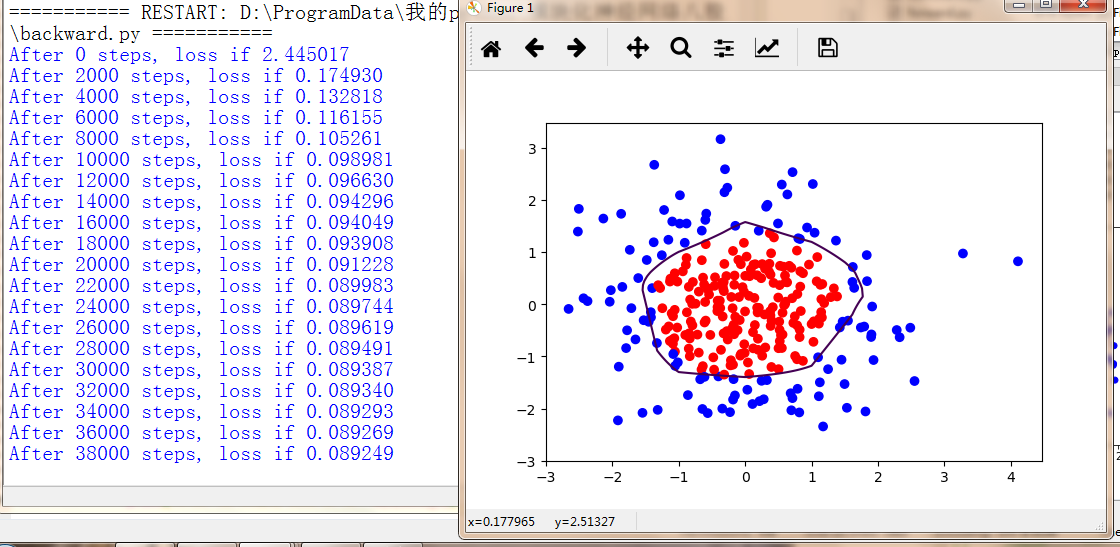实战案例:
数据X【x0,x1】为正太分布随机点,
标注Y_,当x0*x0+x1*x1<2时,y_=1(红),否则y_=0(蓝)

建立三个.py文件
1. generateds.py生成数据集
import numpy as np
import matplotlib.pyplot as plt
seed = 2
def generateds():
#基于seed产生随机数
rdm = np.random.RandomState(seed)
#随机数返回200列2行的矩阵,表示300组坐标点(x0,x1)作为输入数据集
X = rdm.randn(300,2)
#如果X中的2个数的平方和<2,y=1,否则y=2
#作为输入数据集的标签(正确答案)
Y_ = [int(x0*x0 + x1*x1 <2) for (x0,x1) in X]
#为方便可视化,遍历Y_中的每个元素,1为红,0为蓝
Y_c = [['red' if y else 'blue'] for y in Y_]
#对数据集X和标签Y进行形状整理,-1表示n,n行2列写为reshape(-1,2)
X = np.vstack(X).reshape(-1,2)
Y_ = np.vstack(Y_).reshape(-1,1)
#print(X)
#print(Y)
#print(Y_c)
return X,Y_,Y_c
'''
if __name__ == '__main__':
X,Y_,Y_c=generateds()
#用 plt.scatter画出数据集X中的点(x0.x1),Y_c表示颜色
plt.scatter(X[:,0], X[:,1],c=np.squeeze(Y_c))
plt.show()
'''
2. forward.py 前向传播
#coding:utf-8
import tensorflow as tf
#定义神经网络的输入、参数和输出,定义前项传播过程
def get_weight(shape, regularizer):
w = tf.Variable(tf.random_normal(shape),dtype=tf.float32)
#把每个w的正则化损失加到总损失losses中
tf.add_to_collection('losses', tf.contrib.layers.l2_regularizer(regularizer)(w))
return w
def get_bias(shape):
b=tf.Variable(tf.constant(0.01, shape=shape))
return b
#搭建前向传播框架
def forward(x, regularizer):
w1 = get_weight([2,11], regularizer)
b1 = get_bias([11])
#(x和w1实现矩阵乘法 + b1)过非线性函数(激活函数)
y1 = tf.nn.relu(tf.matmul(x, w1) + b1)
w2 = get_weight([11,1], regularizer)
b2 = get_bias([1])
#输出层不过激活函数
y = tf.matmul(y1, w2) + b2
return y
3. backward.py 反向传播
#coding:utf-8
import tensorflow as tf
import numpy as np
import matplotlib.pyplot as plt
import generateds
import forward
STEPS = 40000#共进行40000轮
BATCH_SIZE = 30#表示一次为喂入NN多少组数据
LEARNING_RATE_BASE = 0.001#学习率基数,学习率初始值
LEARNING_RATE_DECAY = 0.999#学习率衰减率
REGULARIZER = 0.01#参数w的loss在总losses中的比例,即正则化权重
def backward():
x = tf.placeholder(tf.float32,(None,2))
y_ = tf.placeholder(tf.float32,(None,1))
X,Y_,Y_c = generateds.generateds()
y=forward.forward(x, REGULARIZER)
global_step = tf.Variable(0, trainable = False)
learning_rate = tf.train.exponential_decay(
LEARNING_RATE_BASE,
global_step,300/BATCH_SIZE,
LEARNING_RATE_DECAY,
staircase = True)
#定义损失函数
loss_mse = tf.reduce_mean(tf.square(y-y_))#利用均方误差
loss_total = loss_mse + tf.add_n(tf.get_collection('losses'))
#定义反向传播方法:包含正则化
train_step = tf.train.AdamOptimizer(learning_rate).minimize(loss_total)
with tf.Session() as sess :
init_op = tf.global_variables_initializer()
sess.run(init_op)
for i in range(STEPS):
start =(i*BATCH_SIZE) % 300
end = start + BATCH_SIZE
sess.run(train_step, feed_dict={x:X[start:end], y_:Y_[start:end]})
if i % 2000 == 0:
loss_v = sess.run(loss_total, feed_dict={x:X,y_:Y_})
print('After %d steps, loss if %f '%(i,loss_v))
#xx在-3到3之间步长为0.01,yy在-3到3之间步长为0.01生成二维网格坐标点
xx, yy = np.mgrid[-3:3.01, -3:3:.01]
#将xx,yy拉直,并合并成一个2列的矩阵,得到一个网格坐标点的集合
grid = np.c_[xx.ravel(), yy.ravel()]
#将网格坐标点喂入神经网络,probs为输出
probs = sess.run(y, feed_dict={x:grid})
#将probs的shape调整成xx的样子
probs = probs.reshape(xx.shape)
#画出离散点
plt.scatter(X[:,0], X[:,1], c=np.squeeze(Y_c))
#画出probs,0.5的曲线
plt.contour(xx, yy, probs, levels=[.5])
plt.show()
if __name__ == '__main__':
backward()
输出:

如果对你有帮助,欢迎打赏!
